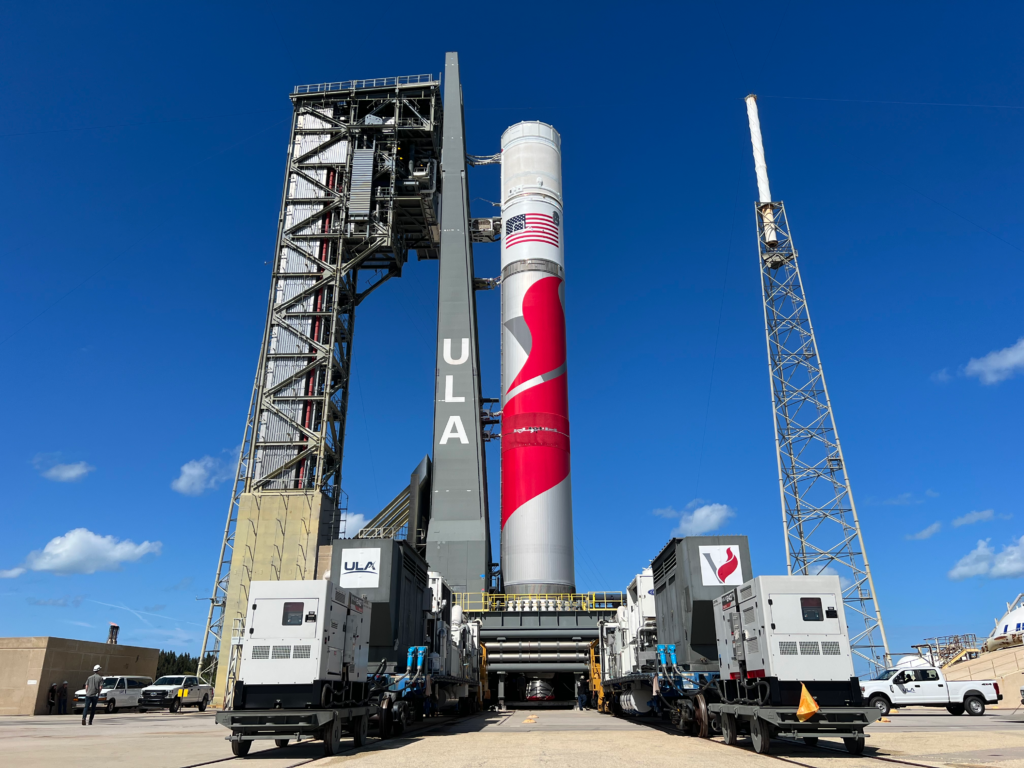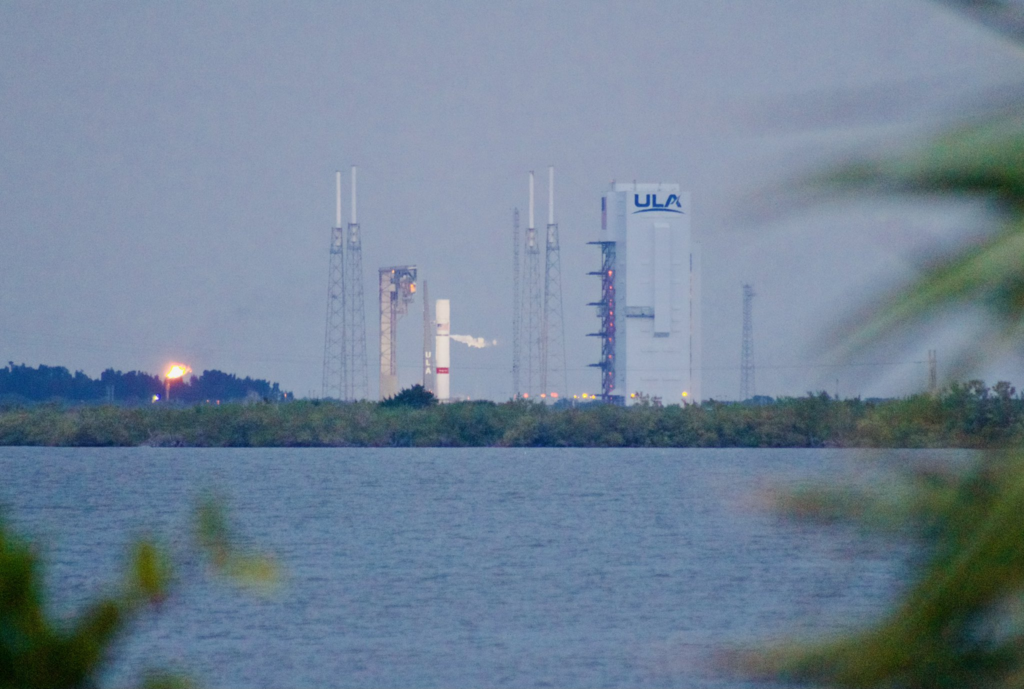
ULA’s Vulcan Is On The Launch Pad For Final Testing
United Launch Alliance (ULA) is known as a very reliable launch provider within the industry with a lot of experience. As its other rockets such as the Delta IV Heavy and Atlas V complete some of their final launches, a new rocket is getting ready to take the stage. The Vulcan Centaur has been under development for years and its maiden flight is scheduled in early May.
Just days ago, the entire rocket with the exception of its fairings was rolled out of the Vertical Integration Facility and onto the launch pad. As I speak, Vulcan is going through the next phase of qualification testing in preparation for the inaugural flight. This includes a host of unique tests to make sure the stage, its engines, the avionics, and different various components are all working as expected.
Assuming the results are promising, a full flight readiness firing will be attempted. The next step will be the first launch of Vulcan and its hardware, not to mention three different payloads heading to various destinations. Here I will go more in-depth into Vulcan’s current testing, what ULA is working on, what to expect in the coming weeks, and more.
Launch Pad Testing

Just yesterday on the 10th ULA tweeted saying, “The VulcanRocket is at the pad for the next phase of qualification testing in preparation for its first certification flight!” Not long before this ULA CEO Tory Bruno provided a timelapse of this process. Here you could see the practically fully stacked Vulcan moved out of the Vertical Integration Facility and onto the pad with its bright red paint job. One obvious feature is the fact that it does not have its payload fairing attached. When asked about this, Tory Bruno commented that they would be added just before launch because there’s no reason to expose precious payloads to risk, no matter how remote, while they are performing these tests.
Speaking of tests, they have already begun. Earlier today ULA tweeted again pointing out, “The temps in Florida may be hot, but #VulcanRocket got frosty! In preparation for the Cert-1 Vulcan flight, the ULA team accomplished the first stage tanking demonstration yesterday at the launch pad.” Here you could see images of Vulcan and almost the entirety of its paint job hidden behind the frost. This test marked the first of multiple apart of this set of qualification requirements.
Specifically, over the next several days, ULA engineers and technicians will put the rocket through pathfinder tests to validate the successful performance of the Vulcan and Centaur stages, Vulcan Launch Platform (VLP), pad facilities, and ground support systems. The tanking tests are meant to verify countdown steps, procedures, and timelines and offer the opportunity to certify the launch team through real-world experience operating the hardware. Initially, the VLP transported the rocket from the Vertical Integration Facility to Space Launch Complex (SLC)-41 on March 9th, riding the rails that connect the two locations. The rocket was stacked on the VLP inside the VIF in late January and the company highlighted that a series of readiness checks since then confirmed that the vehicle was ready to move on to launch pad testing.
Each tanking day is planned to be lengthy and incorporate extensive special test objectives. The expected duration of tests necessitates two shifts of launch console operators, dividing the crew into the “Preps and Tanking Team” and the “Detanking and Securing Team.” After the tanking tests are accomplished, the VLP will disengage from the pad systems for transport of the Vulcan rocket to the VIF for the next step in the countdown to the inaugural launch. In terms of what we can expect, the testing culminates with a Flight Readiness Firing (FRF) to practice the full day-of-launch timeline complete with a brief ignition of the rocket’s main engines.
After the FRF, the rocket will return to the VIF for installation of two solid rocket boosters and its payloads for launch. The first flight includes payloads for three distinctly different missions, deploying two Project Kuiper prototype broadband satellites into low Earth orbit for Amazon, sending Astrobotic’s Peregrine commercial lunar lander to intercept the Moon, and carrying a Celestis memorial payload into deep space. As far as the progress on these payloads and their delivery and integration, earlier today Tory was asked if all four of the payloads had been delivered by now and he replied no. Either way, ULA still plans to wait at least a few weeks before integration which gives the various companies time to deliver the payloads.
Vulcan’s SRBs & PLF

Besides some of the final testing that we are seeing right now, the installation of the two solid rocket boosters will be one of the final steps prior to launch. Last year, the twin solid rocket boosters (SRBs) arrived at the Cape Canaveral launch site. To be specific the Graphite Epoxy Motor (GEM) 63XL boosters arrived Oct. 16 at the Florida spaceport after being trucked from their Northrop Grumman manufacturing plant in Utah. In order to understand the importance of these boosters in the Vulcan launch system, we can look at the different configurations and what they are capable of. Vulcan integrates between 0 and 6 SRBs. The difference in LEO payload capacity for example between 0 and 6 SRBs is over 15,000kg.
Measuring 63 inches (1.6 meters) in diameter and 72 feet (21 meters) in length, each motor is filled with over 100,000 pounds (45,360 kg) of aluminized solid propellant to deliver 463,249 pounds (2.1 mega-Newtons) of thrust at its peak. All GEM 63XL boosters will have fixed nozzles and burn for approximately 85 seconds during launch. GEM 63XL is the latest and most powerful version of the GEM booster family that augments liftoff thrust to give rockets more performance and enables them to carry heavier payloads. The XL variant is longer in length and produces more thrust than the GEM 63 boosters that Atlas V has used successfully since 2020. The two boosters on this initial mission will give the rocket a total liftoff thrust of two million pounds (8.9 mega-Newtons). Looking at the upcoming installation, the SRBs will remain secured on their Over the Road Transporters (ORTs) until each booster is brought to the Vertical Integration Facility ((VIF) for hoisting and attachment to the Vulcan first stage during the launch campaign.
As partially mentioned prior, the fairings also need to be installed along with the payloads right before launch. The Vulcan payload fairing however is quite special in terms of size. The payload fairing (PLF) provides a controlled, safe environment for spacecraft during ascent. All ULA PLFs are configured for off-pad payload encapsulation to enhance payload safety and security and minimize on-pad time. The spacecraft is encapsulated in a 5.4-m- (17.7-ft-) diameter payload fairing (PLF), a sandwich composite structure made with a vented aluminum-honeycomb core and graphite-epoxy face sheets. The bisector (two-piece shell) PLF encapsulates the spacecraft. The payload attach fitting (PAF) is a similar sandwich composite structure creating the mating interface from spacecraft to second stage and payload fairing. The PLF separates using a debris-free horizontal and vertical separation system with spring packs and frangible joint assembly. Most significantly, the payload fairing is available in the 15.5-m (51-ft) standard and 21.3-m (70-ft) long configurations.
Today, Tory Bruno also posted a graphic of the Vulcan’s fairings and answered some questions about it. The graphic highlighted the fairing size of a bunch of different launch vehicles with a whale for scale, with Vulcan’s being the largest. In regard to this, someone asked if work was being done on a larger fairing big enough to hold two whales and he responded yes. ULA points out that access to orbit remains a critical hurdle for many missions. However, the company is trying to provide flexible and cost-effective multi-manifest solutions to overcome this barrier. With multi-manifest, two or more spacecraft are integrated on a launch vehicle using available performance and volume margin that would otherwise go unused — optimizing mass to orbit and enabling missions. Multi-Manifest on a Vulcan rocket provides a highly reliable and schedule certain launch solution for spacecraft ranging from CubeSats to small sats and beyond. This first upcoming mission is a great example with some payloads heading to low Earth orbit and another meant for the surface of the Moon.
Dependent on the size of the spacecraft, multi-manifesting on a Vulcan can be done in several ways. The Aft Bulkhead Carrier (ABC) interfaces at the aft end of the Centaur upper stage and can carry up to 24U CubeSats weighing 80 kg each. The Secondary Payload Adapter (ESPA Ring) is located between the upper stage and the primary payload and can accommodate 4-6 payload modules weighing up to 318 kg each. Finally, for small satellites exceeding the mass of an ESPA capability, the Multi-Payload Canister System is a load-bearing separating canister that can be utilized to enclose an aft small satellite while supporting a forward traditional large satellite. All of which will be put to the test in upcoming missions. It’s also confirmed that the company will be attempted to recover the two BE-4 engines on future missions years down the line.
Conclusion
United Launch Alliance has begun testing the full Vulcan rocket at the launch pad. Yesterday testing began as the company filled Vulcan with propellant to test various systems and procedures. If all the testing goes well, next up will be a flight readiness firing, and then the actual launch attempt, scheduled for May 4th. We will have to wait and see how it progresses and the impact it has on the space industry.
